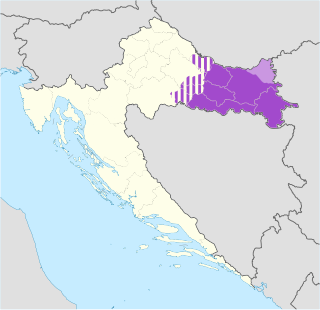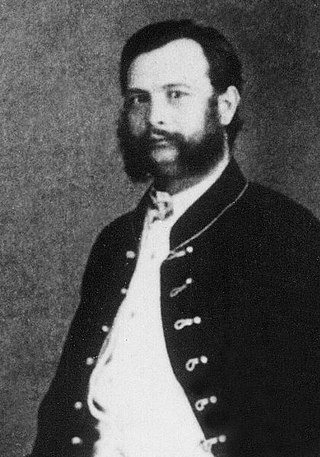
Slavonia is, with Dalmatia, Croatia proper, and Istria, one of the four historical regions of Croatia. Located in the Pannonian Plain and taking up the east of the country, it roughly corresponds with five Croatian counties: Brod-Posavina, Osijek-Baranja, Požega-Slavonia, Virovitica-Podravina, and Vukovar-Syrmia, although the territory of the counties includes Baranya, and the definition of the western extent of Slavonia as a region varies. The counties cover 12,556 square kilometres or 22.2% of Croatia, inhabited by 806,192—18.8% of Croatia's population. The largest city in the region is Osijek, followed by Slavonski Brod and Vinkovci.

Slavonski Brod, commonly shortened to simply Brod, is a city in eastern Croatia, near the border with Bosnia and Herzegovina. Being one of the principal cities in the historical regions of Slavonia and Posavina, Slavonski Brod is the 7th largest city in the country, with a population of 59,141 at the 2011 census. It is the centre of Brod-Posavina County and a major river port on the Sava river.

Franjo Tuđman was a Croatian politician and historian who became the first president of Croatia, from 1990 until his death. He served following the country's independence from Yugoslavia. Tuđman also was the ninth and last president of the Presidency of SR Croatia from May to July 1990.

Matica hrvatska is the oldest independent, non-profit and non-governmental Croatian national institution. It was founded on February 2, 1842 by the Croatian Count Janko Drašković and other prominent members of the Illyrian movement during the Croatian National Revival (1835–1874). Its main goals are to promote Croatian national and cultural identity in the fields of art, science, spiritual creativity, economy and public life as well as to care for social development of Croatia.
In Croatia, there are over 2,900 people who consider themselves German, most of these Danube Swabians. Germans are officially recognized as an autochthonous national minority, and as such, they elect a special representative to the Croatian Parliament, shared with members of eleven other national minorities. They are mainly concentrated in the area around Osijek in eastern Slavonia.
Parliamentary elections were held in the Kingdom of Croatia-Slavonia from 19 to 22 May 1897. The People's Party emerged as the victor.
Ivan Prpić was a Croatian infantry general of the Croatian Home Guard and its chief of staff from 1942 to 1943. He received the Military Order of the Iron Trefoil in 1942.
Ante Paradžik was a Croatian right-wing politician and communist-era dissident. Paradžik was one of the founders of the Croatian Party of Rights.
Turkish Croatia was a geopolitical term which appeared periodically during the Ottoman–Habsburg wars between the late 16th to late 18th century. Invented by Austrian military cartographers, it referred to a border area of Ottoman Bosnia and Herzegovina located across the Ottoman-Austrian border from the Croatian Military Frontier. It went out of use with the Austro-Hungarian rule in Bosnia and Herzegovina.

The Berislavić family of Grabarje, also known as Berislavić family of Dobor, , was a Croatian noble family from the Požega County of Slavonia, allegedly originating from Ban Borić.

The 1940 Croatian local elections were held in 625 municipalities of the Banovina of Croatia on 19 May 1940, and in 33 municipalities on 26 May and 2 June. These were the first elections following the Cvetković–Maček Agreement and the establishment of the autonomous Croatian Banate within the Kingdom of Yugoslavia. The elections were not held in cities and some Adriatic counties bordering, or adjacent to, Italy. Only men older than 24 were allowed to vote. Voting was public and conducted by voice.
Zdravko Dizdar is a Croatian historian.
The Voćin massacre was the killing of 350 Serb civilians in Voćin, Independent State of Croatia, by the Ustaše Croatian fascist organization on 14 January 1942, during World War II. The massacre was carried out as retaliation against the partisans' action in Papuk.

Svetozar Rittig was a Croatian Catholic priest, historian and politician.
Mirko Valentić is a Croatian historian.

Andrija Torkvat Brlić was a writer, linguist, politician and lawyer from Croatia at the time it was in the Austrian Empire. A follower of the Illyrian movement, Brlić was one of the most prominent advocates of unification of South Slavs in the 19th century.
Lav Mazzura was a politician and lawyer born in Zagreb. After studying law in Zagreb and Prague, he became one of leaders of the Croatian Progressive Youth. He was the editor of the Hrvatski pokret and the Hrvatska misao journals. In 1910–1913, Mazzura was a member of the Sabor of the Kingdom of Croatia-Slavonia as a member of the Croat-Serb Coalition led by Frano Supilo and Svetozar Pribičević. He was also a member of the joint Hungarian-Croatian Parliament in Budapest. In November–December 1918, Mazzura was in command of Zagreb-based forces assigned to the Commission for Public Order and Security of the National Council of Slovenes, Croats and Serbs – a body composed of political representatives of the South Slavs living in Austria-Hungary tasked with achieving independence of South Slavic lands from the empire. According to testimony of Slavko Kvaternik, Mazzura was involved in unsuccessful negotiations to peacefully resolve a standoff during the 1918 protest in Zagreb. In 1919, Mazzura was appointed to the post of the prosecutor for the city of Zagreb. He died in Zagreb in 1930.

1997 Eastern Slavonia integrity referendum was held on 6 April in short-lived Serb parallel entity of Eastern Slavonia, Baranja and Western Syrmia which at the time was already governed by the United Nations Transitional Administration for Eastern Slavonia, Baranja and Western Sirmium (UNTAES) as an UN governed territory. Voters were asked whether they supported the proposal for the region of Eastern Slavonia to remain a single territorial oblast within Croatia after the end of UNTAES mandate instead of division into Vukovar-Syrmia and Osijek-Baranja County. Reportedly 99.01% or 99.5% of voters voted for the integrity of the region within Croatia. 77,40% out of 100.275 registered voters participated in the referendum.
Baron Juraj (Gjuro) Rukavina Vidovgradski was a Croatian politician and soldier. He was born in the Trnovec Manor near Krapinske Toplice to Alfred, deputy Varaždin County prefect in Sveti Križ Začretje as one of eight siblings. His grandfather was General of the Artillery Juraj Rukavina Vidovgradski. He attended school in Varaždin before enroling in and graduating from the Theresian Military Academy. He served in the military, rising to the rank of Oberleutnant. Rukavina left the service by 1861 when he met Ante Starčević, the leader and founder of the Party of Rights. Rukavina became a party member and was elected on the party ticket to the Sabor of the Kingdom of Croatia-Slavonia. He also became the president of the Club of the Party of Rights, a leading body of the party, while Starčević retained the overall leadership of the party. Rukavina was the leader of the party members from his native region of Hrvatsko Zagorje. He left the party in 1895 following a conflict with Josip Frank, but he became member once again after Frank and his faction split from the party to form the Pure Party of Rights. Rukavina died in 1915, survived by son Amon.
Tomislav Jonjić is a Croatian jurist, lawyer, historian, politician and former diplomat. He is a research associate at the Croatian Institute of History.











